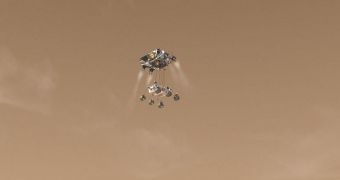As the two spacecraft making up the Gravity Recovery and Interior Laboratory (GRAIL) mission are heading for the Moon, the American space agency is already setting its sights to Mars, preparing to launch the Mars Science Laboratory (MSL) rover Curiosity to the Red Planet.
The past few months have been very busy for the space agency. They included the launch of the Juno mission to Jupiter and the launch of GRAIL, and this period of “turmoil” will end once MSL takes off on November 25. Its launch window stretches until December 18.
This mission will land in the Gale Crater, deployed by the innovative Sky Crane system. If it manages to launch in November, MSL will reach the Red Planet by August 2012, beginning its science operations a few weeks later.
According to experts at the NASA Jet Propulsion Laboratory (JPL), in Pasadena, California, the main purpose of this mission is to search for signs of life on Mars, and also to gain more insight into the planet's wet past.
Juno, GRAIL and MSL are all robotic expeditions, meant to cover gaps in our knowledge of various parts of the solar system. While Juno investigates the nature of the Jovian atmosphere, GRAIL will determine the composition and inner structure of the Moon.
In turn, Curiosity represents the flagship mission for NASA for these years. Another will be achieved when the first Orion Multi-Purpose Crew Exploration (MPCV) vehicle launches for tests, as well as when the James Webb Space Telescope is launched in 2018.
However, it is currently unclear whether the cost overrun-plagued project to build the most complex space observatory ever will come to fruition. Some Congressmen want it shutdown, qualifying it as a money hole. A decision on this topic will be taken soon.
“Today we had the second of NASA's planetary science launches in what we've been calling the 'Year of the Solar System.' Just over a month ago, Juno was thrust on its way off to Jupiter, and today we sent a set of twin spacecraft off to the Moon,” Jim Adams said, quoted by Space.
The official, who holds an appointment as the deputy director of the NASA Planetary Science Division at NASA Headquarters, made the announcement in a news briefing held on Saturday, following GRAIL's successful launch.

 14 DAY TRIAL //
14 DAY TRIAL //